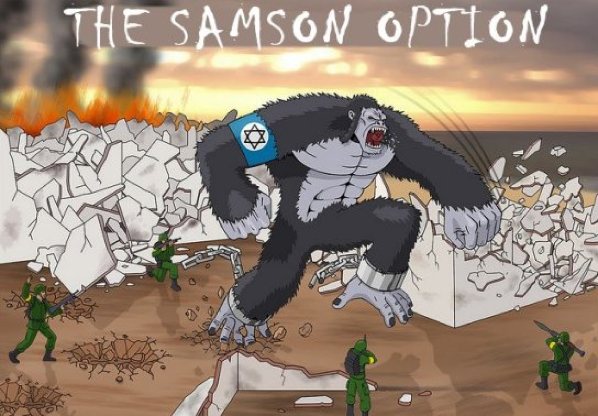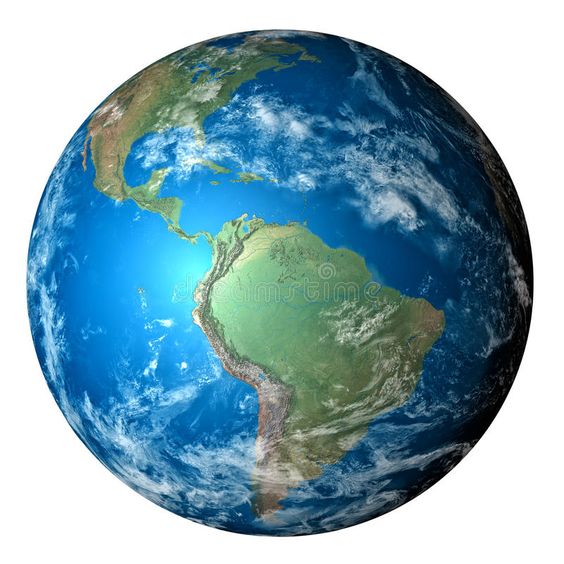
For Israel, the Samson Option is a last ditch deterrent defensive strategy. They do not intend to use nuclear weapons offensively.
By Tom Arms
The Samson Option is a not widely known Armageddon-type Israeli nuclear strategy. The world is worried that Vladimir Putin will adopt it and adapt it to the current crisis.
The strategy is based on the dramatic suicide story of the Biblical strongman Samson.
Shorn of his locks, blinded and a prisoner of the Philistines, the once powerful Samson was brought in chains to the temple of his enemies. He appeared weak, but he retained enough of his strength to throw his chains around the temple pillars and pulled with all his might so that the walls and roof came crashing down, killing the Philistines—and Samson.
Translated into the 21st century military terms, the Samson Option says that if the State of Israel is being overrun and about to cease to exist, the Israelis will use their nuclear arsenal of several hundred missiles and warheads to destroy the invading enemy—and themselves.
Israel’s Arab neighbors believe the threat and it has successfully deterred a serious attack ever since it became known that the Jewish state possessed nuclear weapons.
For Israel, the Samson Option is a last ditch deterrent defensive strategy. They do not intend to use nuclear weapons offensively.
Vladimir Putin’s adaptation is a different case. It has elements of defensiveness but it is linked to his military offensive in Ukraine (and possibly elsewhere in Eastern Europe). This strategy is made more dangerous by tough opposition in Ukraine and the world’s reaction to his invasion and by Putin’s terrifying statement: “if the world does not include Russia why should it exist.”
Additional anxiety is created by the fact that Putin, like so many dictators, has conflated his country’s national interests with his own survival. Furthermore, he sincerely believes in “Russia’s historic mission” to dominate Europe. Conversely, he is convinced that NATO and the EU are thwarting that “historic mission” and in doing so threatening the Russian state which must expand and dominate to survive.
The terrifying conundrum that the world faces is that Putin has placed himself and his country in a position where he must not fail. The West, however, must ensure that he does fail and, is seen to fail.
At the moment, the Russian president is failing in Ukraine. He deluded himself into believing that the close cultural and historical links between Russia and Ukraine would lead the Ukrainian people to realize the error of their ways and welcome Russian troops as liberators. As for the West, he was convinced that they were weak, divided and frustrated by fruitless wars in the Middle East and Afghanistan.
Putin’s miscalculation was colossal. The Ukrainians are valiantly fighting back. A fever of bipartisanship has broken out in Washington and London. The EU has broken precedent to send $500 million worth of military equipment to Ukraine. Germany has overnight raised its defence spending to two percent of GDP. Sweden and Finland are considering joining NATO. There are plans afoot to fast track Ukrainian membership of the EU. Company after company, country after country are applying horrific sanctions or pulling their businesses out of Russia. The ruble is collapsing. Almost all of the Russian stock pile of $1.6 trillion in foreign reserves has either been frozen or is disappearing to pay for the war and support for the ruble.
Putin is facing an economic, political, military—and perhaps most of all— personal Armageddon. He is fast approaching the unpalatable choice fight or die.
In the last few days the Russians have increased the ferocity of their attacks. There is evidence that they have started using cluster bombs which are banned by a 2008 international agreement, albeit one which Moscow has refused to sign. They are clearly attacking civilian targets in several cities and towns. This is a war crime. That Rubicon has been crossed.
But despite the increased attacks, there is no sign of a Ukrainian surrender or a Western collapse. So Putin has the following options: Increase the ferocity of the attacks against Ukraine. Launch cyber-attacks against the West. Stop Russian gas and oil exports to Europe.
It appears that for the time being the energy trade has been largely compartmentalized. Both sides need it. Cyber-attacks are a strong possibility but the West is on high alert with blocking and counter measures.
This leaves escalating the attacks in Ukraine. Tanks, cruise missiles, cluster bombs have all been used. What is next? Possibly a thermobaric bomb. This is an explosive device that ignites the oxygen around a target and creates a firestorm which sucks the air out of the lungs of anyone in the area. Russia has used thermobaric bombs in Chechnya and Syria. Syrian rebels are still fighting. Chechnya continues to simmer. It is unlikely that the Western-backed Ukrainians will be stopped by a thermobaric bomb.
The next frightening step is battlefield nuclear weapons. Putin has ordered his nuclear forces to high alert. There is a whole array of such weapons available to Vladimir Putin involving torpedoes, landmines, depth charges, artillery shells surface to air missiles, air to air missiles and hand-held launchers. There is the neutron bomb and Special Atomic Demolitions. Many of them can be armed with conventional and nuclear warheads. The nuclear explosive yield of a tactical or battlefield nuclear weapon can be up to 10 kilotons which is about 100 times more powerful than the atomic bomb dropped on Hiroshima. Russia is believed to have 2,000 battlefield nuclear weapons.
The next step up is intermediate range nuclear (INF) weapons. These have a range of 600-1,900 miles. They are designed to be used in a cross-border European war. These weapons were meant to be assigned to the nuclear dustbin by the 1987 INF Treaty, but in 2008 Russia started developing and deploying new INF weapons including the SSC-8, the SS-25 and the RS-26. The nuclear capable Iskander-M is sort of halfway between a tactical and intermediate range weapon with a range of up to 300 miles. It is deployed in Russian-annexed Crimea. The INF Treaty was scrapped by the US in 2019 because of Russian violations.
The final terrifying escalation is strategic nuclear weapons. Russia has the world’s largest nuclear arsenal with 5,997 warheads.
This is why NATO doesn’t want to risk their troops facing Russian troops either in the air, land or at sea. But if a frustrated Putin uses nukes against the Ukrainians then….
- Let’s start with Belarus, key launch pad for the Russian invasion and now virtually no longer an independent state. Of course, it has been going that way for a few years and when the West imposed sanctions after the rigged 2020 elections dictator Alexander Lukashenko sold out to Putin’s ruble in order to stay financially afloat. However, the Belarussian leader retained a fig leaf of independence by continuing to refuse to allow Russian troops to be based on his country’s soil. Well, that has now ended with Belarus becoming a major launch pad for the Russian invasion of Ukraine. On top of that, a constitutional referendum last weekend went a step further and approved a measure that allows Russian nuclear weapons to be based in Belarus. The country’s economic, defence and foreign policy is now dictated from Moscow and 80,150 square miles has been added to the Russian empire.
- The European political chairs continue to rearrange themselves across the geopolitical map. Sweden has been neutral for 200 years. In the wake of the Russian invasion, opinion polls are for the first time shifting in favor of ending this long-held position and joining NATO. The powerful Social Democrats, however, remain opposed. Finland has been neutral since 1945. It has a 780-mile long border with Russia and a long history of conflicts with Moscow. Its government is on the cusp of announcing a referendum on NATO membership. The latest opinion polls show 53 percent for and 28 percent against. Both the Swedes and the Finns have been members of the EU since 1995 and have been in the forefront in supplying aid to Ukraine. Vladimir Putin has warned the two countries that joining the Western military alliance would result in “detrimental and military consequences.”
- There is movement too in Eastern Europe where Putin’s three targets—Ukraine, Moldova and Georgia have all issued statements saying they want to join the economic arm of the Western Alliance—the European Union. This would mean crossing another one of Putin’s oft-stated red lines. But membership involves more than just a “May I please join your club” request. The process usually takes years while the “candidate” countries adapt laws and regulations to Brussels requirements and jump through hoops related to democratic structures, human rights, an independent judiciary and anti-corruption measures. Ukraine’s request came during President Volodomyr Zelensky’s speech this week to the European Parliament. In a tidal wave of emotional support a raft of MEPs called for plucky Ukraine to be put on the fast track to membership. A coterie of French-led MPs, however, pointed out that—according to Transparency International—Ukraine is the second most corrupt country in Europe (Russia is the first). Moldova was spurred into action by a Lukashenko press conference in which the Belarussian dictator displayed a map which showed Moldova as the next target for invasion. There are already 1,500 Russian troops in Moldova based in the breakaway Russian-speaking Transnistra Province. As for Georgia, they have been expecting a full-scale Russian takeover since Putin’s tanks grabbed South Ossetia and Abkhazia in 2008.
- There was another major speech this week in Washington: President Joe Biden’s first State of the Union Address (aka SOTU). His pledges of unwavering support for Ukraine resulted in a rare and vociferous display of bipartisan support which rivals the unity being displayed in Europe. Biden said Putin struck because he thought the West was divided. “He was wrong,” said the President. “We are ready. We are united.” He went on to promise that “Putin’s war will leave Russia weaker and the rest of the world stronger.” However, Biden’s fine words were tempered with a refusal to commit any troops to fighting in Ukraine. Forces are being rushed to the Eastern flank of the Western Alliance to protect “every single inch” of NATO but “our forces are not engaged and will not engage in the conflict with Russian forces in Ukraine.” Meanwhile Donald Trump, de facto leader of the American Opposition, is reversing his position on Putin’s invasion. Last week he described Putin as “genius”. This week he said the attack was “a holocaust.” A volte face from double-down Trump is a big news.
- Most of the world continues to line up behind Europe and the US against Putin. But not everyone. One interesting surprise is a big chunk in the Middle East. Iran is understandable on the basis of your enemy is my enemy, but both the Saudi and the United Arab Emirates—usually seen as American proxies in the Arab world—are backing the Russians. There are two main reasons for this. The first is that the two OPEC stalwarts have close relations with Moscow through the oil cartel. Russia in fact, is an unofficial member and the cartel is now regularly referred to as OPEC + 1. The other reason is dissatisfaction with the Biden Administration which has cut off arms supplies to Saudi and UAE forces fighting Houthi rebels in Yemen. Russia has quickly filled the supply gap and won kudos from the Arab armies. Even Israel’s support for the West is lacklustre at best. It has sent humanitarian aid to Ukraine but refused to send weapons and has asked the US and UK not to sanction controversial Russian oligarch Roman Abramovich because of his support for Jewish charities. The weak support from Israel is likely linked to its own expansionist territorial ambitions and the fact they would be undermined if Putin fails to annex Ukraine.
- Another chink in the anti-Putin alliance is the South Asian antagonists Pakistan and India, both of whom are neutral leaning towards Moscow. Pakistan Prime Minister Imran Khan was visiting Putin on the day the invasion started. India is a key member of the anti-Chinese Quad alliance but now the US is considering sanctions against the Indians because they abstained from a UN General Assembly vote condemning the Russian invasion. Pakistan wants to maintain good relations with Moscow because of instability in Afghanistan. The Indian army has long-standing and close relations with Russia which remains one of the country’s main weapons suppliers. But both countries share a common cause that pushes them towards support for Putin: Kashmir. The Russian invasion of Ukraine is about competing claims based on territory, culture and history. So are the competing claims in Kashmir of Pakistan and India.
- China continues to walk the Ukrainian tightrope but is starting to lean ever so slightly towards Kyiv. A news anchor on Chinese state television appeared dressed in the Ukrainian colors of blue and yellow. Chinese foreign minister Wang Yi met with his Ukrainian counterpart and upgraded his description of the invasion to “from deteriorating situation” to “conflict.” The Chinese –controlled Asian International Infrastructure Bank (AIIB) has stopped loans to both Russia and Ukraine. This weekend there is a meeting of the Chinese National Assembly. Watch it for more directional wind changes. China is torn on multiple levels. It has 60,000 nationals living in Ukraine. It exports 90 percent of its grain from Ukraine. But it is also the world’s largest energy importer and much of its fuel comes from Russia. In addition, there is little doubt that there is a strong personal relationship between Presidents Vladimir Putin and Xijingping, although both men would probably throw the other under a speeding tank if it served their purpose. Geopolitical considerations also loom large. Ukraine is forcing to reassess its relationships across the board—with Russia, Taiwan, Europe, India, and Australia…. It is very aware that the showdown on the other side of the Eurasian land mass is being viewed around the globe as a battle between autocracy and democracy, and, if democracy wins, it is bad news for autocracy in China and elsewhere. So, for the time being, Beijing continues its tightrope walk.
________________
 Tom Arms is foreign editor of Liberal Democrat Voice and the author of “The Encyclopedia of the Cold War” and the recently published “America Made in Britain” that has sold out in the US after six weeks but is still available in the UK.
Tom Arms is foreign editor of Liberal Democrat Voice and the author of “The Encyclopedia of the Cold War” and the recently published “America Made in Britain” that has sold out in the US after six weeks but is still available in the UK.
